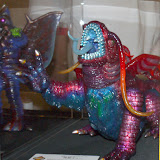Today on his Twitter and Blog, Umezz (or perhaps simply his webmaster Demerin) name-checked Same Hat and the recent series of guests reports by the TOKYO SCUM BRIGADE boys. I have talked briefly online to Demerin before via YouTube, and passed along the latest posts hoping she'd give them a look. It also sounds like the TSB guys spoke to Umezu's people while at the Rock Event this past weekend!
Regardless of how exactly it came about, getting Same Hat name-checked on Umezz.com is a dream come true. Now to meet the man! You can check out the original post here. Many, many thanks again to Tokyo Scum Brigade for sharing the wealth with all us Umezz fanatics.
For new folks, you can check out all my earlier Kazuo Umezu posts here!









